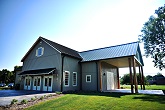Acrylic Workshop - 443528
Acrylic Workshop
Acrylic Workshop
This versatile medium can be applied with a variety of brush strokes, resulting in a broad scope of interesting visual effects. A strong composition evolves from our emphasis on design and value. The class includes progressive subject matter, new techniques, individual attention and constructive critique. A very supportive atmosphere. All levels welcome. A supply list is included within your pdf receipt emailed immediately following registration (double check your email address is correct at registration).
Acrylic Workshop Supply List
Paint
-There are many different brands of acrylic paint. The most common ones are Liquitex, Golden, and Winsor and Newton. Other brands such as Maimeri Brera, Holbein, Van Gogh, Daler Rowney and Utrecht are fine too. I do not use student grade paints like Galeria or Basics.
Paint Colors
My choice of colors may vary somewhat from yours. Obviously you need some basics. I also include some personal favorites.
-Ultramarine blue. Cereulean and cobalt blue and thalo blue are also good.
-Cadmium red. Alizarin and crimson are also good.
-Cadmium yellow. Hansa and lemon yellow are also good.
-Hookers green. Sap green, thalo green and chromium oxide are also good.
-Paynes grey
-Dioxazine purple or permanent violet
-Burnt sienna
-Burnt umber
-Yellow ochre or raw sienna
-Cadmium orange
-Titanium white
You do not need to start with all the suggested personal favorites but you will need at least ten basic colors. Orange can be omitted at first. One color I love is quinacridone gold which may be hard to find.
Brushes
-You may use bristle or synthetic brushes made for acrylic painting. Watercolor brushes can also be used. Please also bring a number 4 or number 6 round and a liner. You will especially need a 1 inch flat and a one and a half inch synthetic flat brush. As a suggestion for other brushes, I use a number 10 which is a one inch short flat, a number 10 filbert, and a number 6 round, all Acrylix by ProArte. I also have a number 3 and number 6 flat bristle.
Painting Supports
-Canvas or canvas boards. You do not need to start with anything over 16 x 20 but nothing smaller than 12 x 16. Some sturdy drawing paper or canvas in a tablet form to test colors.
Other Helpful Items
-Large water containers, rags, paper towels, palette knife or painting knife, disposable paper palette, cling wrap if you want to save paint, water spray bottle, old tooth brush, table easel if you have one or floor easel if you prefer, drawing pencil, eraser and a small sketch pad. A large piece of plastic or an old tablecloth is helpful to prevent table damage.
Call the instructor with any questions at 614 451 6254. You may bring examples of your work to the first class. Unless washed immediately, acrylics stains on clothing are permanent so dress accordingly.
ART SUPPLY STORES
Dick Blick Co.
6486 Sawmill Road, 614 792 1900
Paint
-There are many different brands of acrylic paint. The most common ones are Liquitex, Golden, and Winsor and Newton. Other brands such as Maimeri Brera, Holbein, Van Gogh, Daler Rowney and Utrecht are fine too. I do not use student grade paints like Galeria or Basics.
Paint Colors
My choice of colors may vary somewhat from yours. Obviously you need some basics. I also include some personal favorites.
-Ultramarine blue. Cereulean and cobalt blue and thalo blue are also good.
-Cadmium red. Alizarin and crimson are also good.
-Cadmium yellow. Hansa and lemon yellow are also good.
-Hookers green. Sap green, thalo green and chromium oxide are also good.
-Paynes grey
-Dioxazine purple or permanent violet
-Burnt sienna
-Burnt umber
-Yellow ochre or raw sienna
-Cadmium orange
-Titanium white
You do not need to start with all the suggested personal favorites but you will need at least ten basic colors. Orange can be omitted at first. One color I love is quinacridone gold which may be hard to find.
Brushes
-You may use bristle or synthetic brushes made for acrylic painting. Watercolor brushes can also be used. Please also bring a number 4 or number 6 round and a liner. You will especially need a 1 inch flat and a one and a half inch synthetic flat brush. As a suggestion for other brushes, I use a number 10 which is a one inch short flat, a number 10 filbert, and a number 6 round, all Acrylix by ProArte. I also have a number 3 and number 6 flat bristle.
Painting Supports
-Canvas or canvas boards. You do not need to start with anything over 16 x 20 but nothing smaller than 12 x 16. Some sturdy drawing paper or canvas in a tablet form to test colors.
Other Helpful Items
-Large water containers, rags, paper towels, palette knife or painting knife, disposable paper palette, cling wrap if you want to save paint, water spray bottle, old tooth brush, table easel if you have one or floor easel if you prefer, drawing pencil, eraser and a small sketch pad. A large piece of plastic or an old tablecloth is helpful to prevent table damage.
Call the instructor with any questions at 614 451 6254. You may bring examples of your work to the first class. Unless washed immediately, acrylics stains on clothing are permanent so dress accordingly.
ART SUPPLY STORES
Dick Blick Co.
6486 Sawmill Road, 614 792 1900
Fees
Charge When Not Billed:
LifeLong Learning (R) (Standard Fee): $114.00 = $114.00
Charge When Not Billed:
LifeLong Learning (NR) (Standard Fee): $138.00 = $138.00
